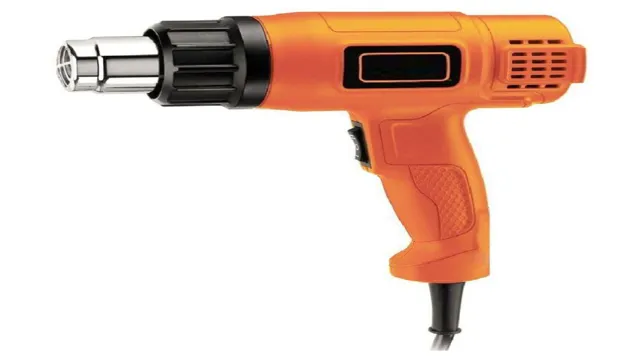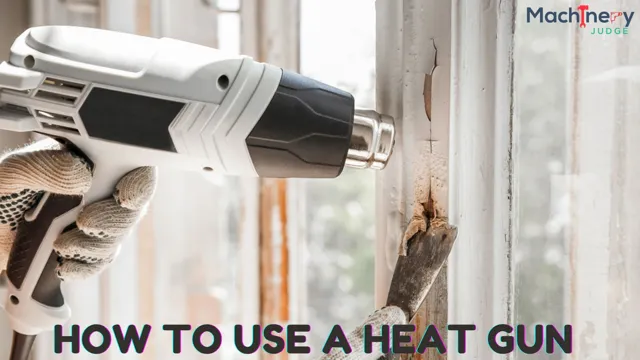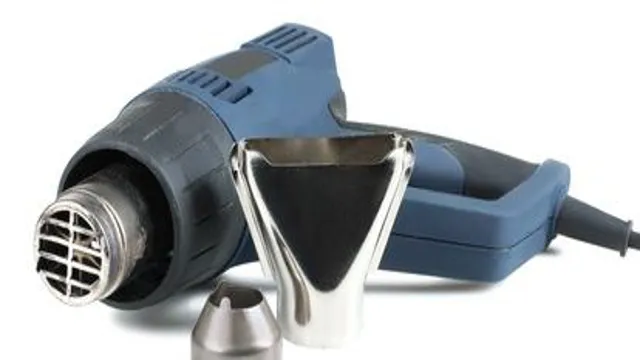How to Remove Paint with a Heat Gun: A Step-by-Step Guide
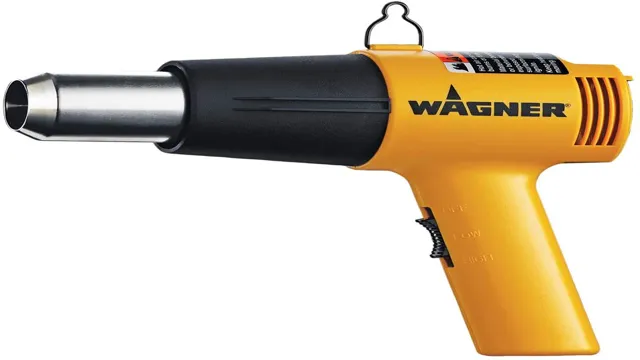
Tired of the paint on your walls, furniture, or even your car? Removing paint can be an extremely tedious and time-consuming task, especially when using traditional methods like solvents and sanding. However, have you ever considered using a heat gun? A heat gun is a powerful tool that uses hot air to soften and remove paint on a variety of surfaces. It’s a fantastic alternative for those who want to avoid chemicals and minimize damage to their surfaces.
In this blog post, we will explore the benefits of using a heat gun to remove paint and provide you with step-by-step instructions on how to use it. So, if you’re ready to get started on your next DIY project, grab your heat gun and let’s get to work!
Introduction
Removing paint can be a daunting task, but it doesn’t have to be if you have the right tools. If you’re wondering how to remove paint with a heat gun, you’re in luck. A heat gun is a versatile tool that can be used for a variety of tasks, including paint removal.
To start, make sure you’re wearing gloves and safety glasses to protect your skin and eyes. Then, set your heat gun to the appropriate temperature for the paint you’re trying to remove. Heat the paint for several seconds at a time, and then use a scraper to peel away the softened layers.
Repeat the process until all the paint is removed. With a heat gun and a little patience, you can easily remove paint from any surface.
Why Use a Heat Gun
As much as we avoid it, there are various times when we have to deal with materials that need extreme heating or cooling. Whether you’re a DIY enthusiast or a professional tradesperson, there will come a time when you’ll face this challenge. This is where a heat gun comes in handy.
Heat guns are tools that are widely used to provide a controlled flow of hot air directed to a specific area that needs heating. They are versatile tools that have a vast range of uses, such as stripping paint, thawing frozen pipes, melting plastic, shrink-wrapping, and much more. With their help, you can complete your tasks quickly and efficiently.
In this article, we will explore the reasons why you should consider using a heat gun in your work. So, let’s dive in and discover the advantages of using a heat gun for your projects.
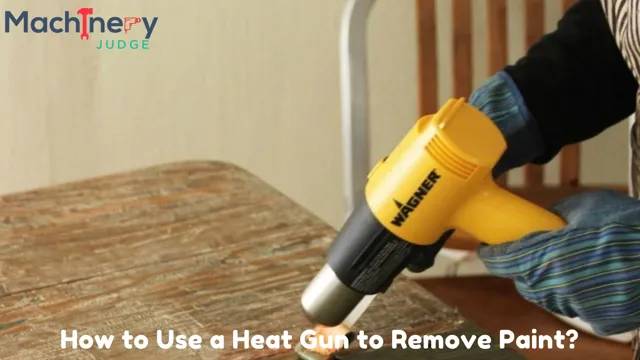
Safety Precautions
When it comes to ensuring our safety, there are a variety of precautions that we can take to protect ourselves and those around us. These precautions can range from simple measures such as wearing a seatbelt while driving or using a helmet while riding a bike, to more complex safety protocols in hazardous work environments. Regardless of the situation, the most effective way to avoid accidents and minimize risk is to take the necessary steps to prevent them from occurring in the first place.
By consistently implementing safety practices and being mindful of potential hazards, we can create a safer environment for everyone. In order to ensure safety, keyword, it is imperative to introduce and maintain a culture of awareness and preparedness.
Steps to Remove Paint with a Heat Gun
If you’re looking for a way to remove paint from your walls or furniture, using a heat gun is a great option. Not only is it efficient, but it’s also relatively easy to do. First, you’ll need to purchase a heat gun, which can be found at your local hardware store.
Next, put on a pair of heavy-duty gloves and protective goggles to keep your hands and eyes safe. Begin by holding the heat gun about 2-3 inches away from the surface you’re trying to remove paint from, and move it back and forth in a circular motion. You’ll notice the paint start to bubble and peel away.
Once the paint has softened, use a scraper or putty knife to gently scrape away the paint. Be careful not to hold the heat gun in one place for too long, as it can cause damage to the surface underneath the paint. With patience and persistence, you can remove all the paint in no time with this method.
Prepare the Area
One of the essential steps to remove paint with a heat gun is to prepare the area. This step involves clearing the working space of any obstacles, movable items, or flammable materials that might ignite or catch fire. To ensure safety, the area should also be well ventilated, and any nearby windows or doors should be opened before starting the paint removal process.
You can also protect nearby walls, furniture, or fixtures by covering them with plastic or drop cloths. This way, you can prevent paint dust, debris, or chips from falling on unprotected surfaces or causing damage. By taking the necessary precautions to prepare the area, you can work efficiently and safely with your heat gun to remove paint from any surface.
Select the Right Heat Gun
Selecting the right heat gun is crucial when it comes to removing paint effectively. Firstly, you must ensure that the heat gun has various temperature settings so that you can control the heat depending on the type of paint and the surface it’s on. Secondly, the nozzle of the heat gun must be suitable for the task at hand.
The nozzle should direct the heat onto the surface of the paint without causing any damage to the surface underneath it. Another important feature to consider is the power output of the heat gun. A high wattage heat gun can remove paint quickly, but it can also damage the surface underneath it.
Finally, make sure that the heat gun is easy to use and handle. A comfortable grip and good weight distribution can make a big difference when you’re working on a difficult project. By following these steps, you can select the right heat gun to remove paint quickly and safely without damaging the surface underneath.
Set Up the Heat Gun
If you want to remove paint from a surface, using a heat gun can be an effective solution. To start, the first step is to set up the heat gun. Make sure to read the instructions on your specific heat gun before using it.
Then, plug the heat gun into an electrical outlet and turn it on. For safety reasons, wear protective gear such as gloves and goggles to avoid any accidents. Keep the heat gun about 2-3 inches away from the painted surface and move it back and forth in a sweeping motion until the paint starts to loosen and bubble.
Once the paint is softened, use a scraper to remove it from the surface. Remember to keep the heat gun moving and not focus on one spot for too long to avoid scorching or burning the surface. By following these steps, you can effectively remove paint using a heat gun.
Heat the Paint
If you’re looking for a quick and efficient way to remove paint, a heat gun might be just what you need. Heat guns are great for softening up paint so that it can be scraped off easily, which makes them the perfect tool for anyone looking to give their walls or furniture a fresh new look. To get started, simply plug in your heat gun and turn it on to the appropriate temperature.
Then, hold the gun a safe distance from the surface you’re working on and move it back and forth until the paint begins to soften. Once the paint has loosened up, use a scraper or putty knife to peel it away. Just be sure to wear gloves and work in a well-ventilated area to avoid any potential health hazards.
Removing paint with a heat gun can be a bit messy, but the end result is well worth the effort. So why not give it a try and see what kind of transformation you can achieve?
Scrape the Paint
If you’re looking to remove paint from a surface, using a heat gun is a quick and efficient method. However, it’s important to take the proper steps to ensure a successful outcome. The first step is to prepare the area by covering nearby surfaces and wearing protective gear such as gloves and goggles.
Then, use the heat gun to soften the paint, working in small sections at a time. Once the paint is loosened, scrape it away using a putty knife or paint scraper. Repeat the process until all the paint has been removed.
It’s important to be patient and take breaks as needed to avoid burning the surface. Overall, using a heat gun can be a great option for removing stubborn paint, but it’s important to take the necessary precautions and follow proper technique.
Repeat Until All Paint is Removed
Removing paint can be an arduous task, but using a heat gun can make the process much easier. The first step is to prepare the area by putting on protective gear, such as gloves and goggles, to avoid any potential hazards. Next, set the heat gun to the lowest possible heat setting to prevent damaging the surface underneath the paint.
Hold the heat gun about 2-3 inches away from the paint and move it back and forth until the paint starts to bubble. Using a scraper, gently remove the bubbled paint, being careful not to gouge the surface. Repeat this process until all of the paint is removed.
Remember, safety is key, so it is important to take breaks and not overheat the gun. With patience and care, using a heat gun can be an effective way to remove paint without damaging the underlying surface.
Finishing Touches
Removing paint can be a daunting task, but using a heat gun can make the process much easier. Before using a heat gun, make sure to wear protective gear such as gloves and safety glasses. Hold the heat gun about 2-4 inches away from the surface and move it in a constant back-and-forth motion.
As the paint begins to soften, use a scraper to remove it. It’s important to work in a well-ventilated area as fumes may be released during the process. Once all the paint has been removed, clean the surface thoroughly before applying any new coats of paint.
Using a heat gun can be a quick and effective way to remove paint from various surfaces and give them a fresh new look.
Clean Up the Surface
Now that you have completed the hard work of painting your walls, it’s time to give it a finishing touch that will make all the difference in the overall appearance of the room. One small yet significant step is to clean up the surface. No matter how careful you were while painting, there is a high possibility that you left some drops of paint or smudges on the surface.
It’s important to remove them before they dry out and become difficult to remove. A wet cloth or sponge with a little bit of soap can do the trick. If you have missed out any spots, use a razor blade or sandpaper to scrape off the excess paint gently.
Remember to be careful while using these tools as you don’t want to damage the freshly painted wall. With this last step, your newly painted walls will look crisp and clean, elevating the overall look of the room.
Dispose of Paint Scraps
As much as we love to paint, there’s always some leftover paint scraps or cans that need to be disposed of properly. Pouring paint down the drain or tossing it in the trash can have harmful effects on our environment. The good news is that there are several ways to dispose of paint scraps safely.
One way is to donate it to a community organization or school that uses paint for murals and art projects. Another way is to mix the paint with kitty litter or sawdust and let it dry before disposing of it in the trash. You can also take it to a local hazardous waste disposal facility that accepts paint.
By taking the time to properly dispose of your paint scraps, you’re not only protecting the environment but also ensuring the safety of yourself and those around you. Let’s do our part in keeping our planet clean and healthy!
Conclusion
In conclusion, if you ever find yourself in a sticky situation with paint that just won’t budge, a heat gun can be your trusty companion. Like a superhero with a fiery ability, the heat gun can effortlessly melt away layers of paint with precise control. However, just like with great power comes great responsibility, the heat gun should be handled with caution and safety measures should be taken.
So, go ahead and unleash the power of the heat gun to reveal a fresh canvas underneath your old paint job!”
FAQs
What safety precautions should I take before using a heat gun to remove paint?
Before using a heat gun, make sure to wear protective gear such as safety glasses, gloves, and a respirator. Additionally, create an adequate ventilation system by opening windows or using fans to prevent inhaling any harmful fumes or dust.
Is a heat gun the best method for removing paint?
While using a heat gun can be effective, it’s not always the best method for every situation. Consider the material you’re working with and the type of paint before deciding on a removal method. For example, heat guns might not be the best choice for removing lead-based paint.
How long does it take to remove paint with a heat gun?
The time it takes to remove paint with a heat gun can vary based on the thickness of the paint, the surface area, and the heat gun’s power. Generally, it can take anywhere from a few seconds up to several minutes per area.
Can I use a heat gun on all surfaces?
Not all surfaces can handle the high temperature of a heat gun. It’s important to check the manufacturer’s instructions before using a heat gun on any surface. Some materials, like plastics, can melt or warp under high heat, so it’s best to avoid using a heat gun on those surfaces.
How do I know when the paint is ready to be removed with a heat gun?
Look for signs like bubbling or peeling paint to determine when the heat gun is heating the paint enough for it to be removed. Additionally, using a scraper or putty knife to test the paint’s adhesion can indicate if it’s ready to be removed.
What’s the best way to clean a heat gun after use?
After using a heat gun, wait for it to cool before wiping it down with a soft cloth or using a brush to clean any dust or debris. Avoid using water or solvents, as they can damage the heat gun’s electrical components.
What should I do if the paint isn’t coming off with a heat gun?
If the paint is stubborn and won’t come off with a heat gun, consider trying a different removal method, like chemical paint stripper or sanding. Make sure to wear proper protective gear and follow manufacturer’s instructions when using any type of removal method.

